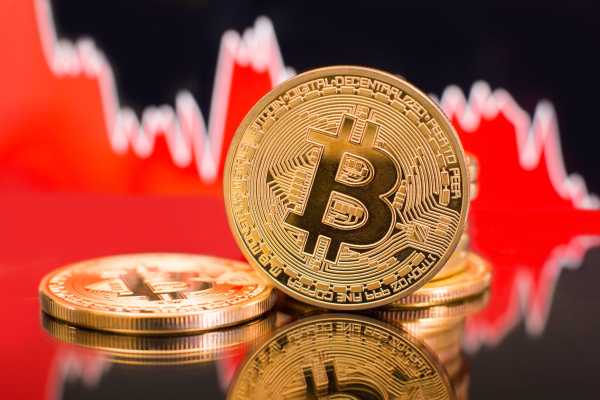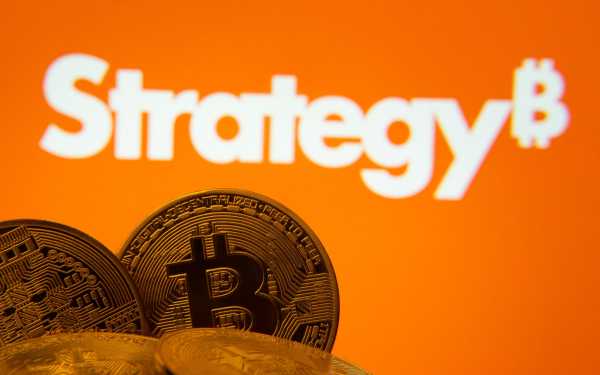Why Is Crypto Up Today?


The crypto market is up today amid expectations for crypto-friendly policies in the US, the US Federal Reserve rate cuts, the European Central Bank (ECB) lowering its key interest rates, and the People’s Bank of China cutting its benchmark one-year lending rate.
Some analysts argued that Bitcoin could hit $160,000 by 2025, further bolstered by the US economy.
Others noted that BTC could surge to $200,000 by mid-2025.
At the time of writing, the global cryptocurrency market capitalization is unchanged. Over the last 24 hours, it recorded just a 0.1% increase, now standing at $3.94 trillion.
The daily crypto trading volume is $296 billion.
Also, 66 of the top 100 coins per market cap have seen their prices decrease today, while 44 have appreciated.
Nonetheless, all individual categories are up on average.
Top 10 Coins Are Up 2% On Average Today
The majority of the top 10 coins per market cap have seen their price rise today.
Only two coins are down, both than less than 0.5%, meaning that their prices are unchanged.
The two coins are Solana (SOL) and Dogecoin (DOGE), currently trading at $217.65 and $0.40005, respectively.
The day’s best performer is XRP (XRP). It appreciated 8.2% to the price of $2.58.
The rest of the green list is up between o.1% and 2.7%.
Bitcoin (BTC) increased by 2.6%, trading at $107,351, after hitting a new all-time high of $107,822 on 16 December.
Ethereum (ETH) appreciated 1.8%, changing hands at $4,016.
Speaking of Ethereum, its largest whale wallets now hold 57% of the total ETH supply. The top 104 whale wallets, each holding over 100,000 ETH, collectively control around $333 billion worth of the coin.
Also, on Monday, Ethereum spot exchange-traded funds (ETFs) saw a 16th consecutive day of net inflows, recording $51 million.
Meanwhile, the defunct crypto exchange Mt. Gox moved $172.54 million in BTC to an unknown wallet earlier today.
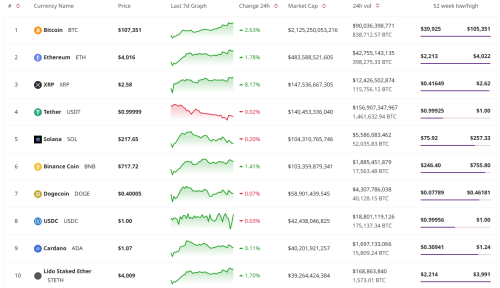
Top 10 Meme Coins Are Up 1% On Average Today
Most of the top meme coins are up today, while four are down.
Coq Inu (COQ), yesterday’s biggest gainer, decreased the most today: 2.44%.
The other three coins are down below 1% per coin.
At the same time, the increases range between 0.2% and 5.7%. The latter percentage is recorded by Baby Doge Coin (BABYDOGE) as the day’s best performer.
It’s followed by Bonk (BONK)’s increase of nearly 3%.
The category’s first coin per market cap, Dogecoin (DOGE), increased 0.4% to $0.4, while the second coin, Shiba Inu (SHIB), remained unchanged at $0.00003.
As for BABYDOGE, the team behind it announced today that the coin would enter the Korean market via the listing on the KCEX spot trading market.
They are also preparing to launch the puppy.fun meme coin launchpad in a matter of days.
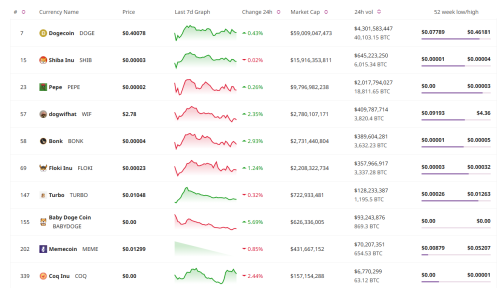
Top 10 AI Coins Are Up 0.9% On Average Today
Four of the top AI coins recorded drops in their prices over the past 24 hours.
While three fell below 1% per coin, Akash Network (AKT)’s price decreased by 3% to the price of $3.6.
On the other hand, AIOZ Network (AIOZ) increased by 5.2% to $1.13, making it the day’s best performer.
Theta (THETA) follows with a rise of 3% to $2.7.
Near Protocol (NEAR), the top coin in this category, is up nearly 3%, now trading at $6.8.
Meanwhile, the AIOZ team tweeted today that the SOLO mining chain integrated AIOZ W3IPFS for decentralized file storage, thus enhancing data storage efficiency and user experience.
On Monday, the team said it had presented a study titled ‘Surpassing State-of-the-Art VQA with Deep Learning Optimization Techniques and Limited GPU Resources’ at NVIDIA GTC 2019, sharing key insights on optimizing GPUs for deep learning and showing how they developed an “efficient Visual Question Answering (VQA) system using limited resources.”
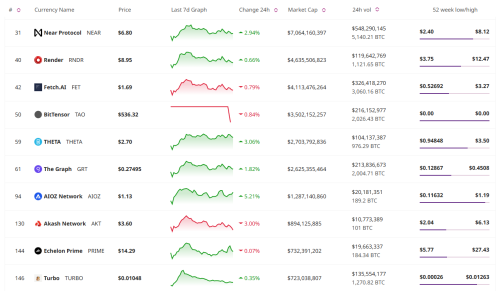
Top 10 Metaverse Coins Are Up 1.4% On Average Today
Only one of the top ten metaverse coins has recorded an increase over the past 24 hours.
While the best performer yesterday, Stacks (STX) is the category’s only drop today, having decreased by 3.8% to the price of $2.37.
The highest increase is ApeCoin (APE)’s 3.8%, currently trading at $1.6.
It’s followed by Axie Infinity (AXS) and its 3.5% rise to the price of $7.61.
The top two coins in this category, Internet Computer (ICP) and Render (RNDR), are up below 1% each, changing hands at $12.72 and $8.95.
Meanwhile, ApeChain announced its latest integration today, this time with Orbiter Finance, while on Monday it said that Cyan, a buy now pay later service for the metaverse, went live on ApeChain.
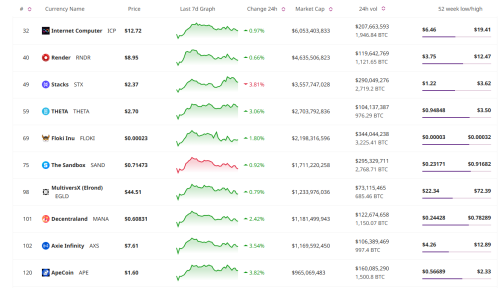
Top 10 Gambling Coins Are Up 0.3% On Average Today
The top 10 gambling coins did not do as well as the previous categories.
Its daily increase of 0.1% is so minimal that the average is practically unchanged.
Four coins have recorded increases. Two more are technically green but are unchanged.
Wownero (WOW) rose by 5.6% to $0.15035, making it the category’s best performer.
Dotmoovs (MOOV) comes next, having seen a 3.8% rise to the price of $0.00224.
Other green coins are up 1.7% and less.
As for the red coins, Rollbit Coin (RLB), the category’s top coin, fell the most: 5.3% to $0.13349.
The rest of the list is down between 0% and 2.4%.
Dotmoovs recently partnered with Kutsaca, a Mozambique-based organization that empowers vulnerable children through sports, creativity, and education. The team is preparing “a special event” to celebrate this collaboration, they said.
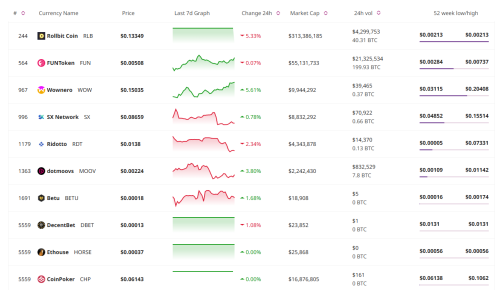
Read more: What’s Happening In Crypto Today? Daily Crypto News Digest
Key Factors Behind Crypto Market Increase
The cryptocurrency market is influenced by a wide variety of factors. Each may affect it differently, but the price will likely reflect it.
Some of these factors are close to home, so to speak. However, some are seemingly far removed yet intertwined with the crypto market to a certain degree.
Here’s a comprehensive list of key reasons why the crypto market might go up.
1. Positive Market Sentiment
- Investor optimism: When investors feel confident about the future of cryptocurrencies, they are more likely to buy. Subsequently, this drives prices up.
- Media coverage: Positive media stories can create a ‘FOMO’ (Fear of Missing Out) effect, prompting more people to enter the market. The power of media coverage shouldn’t be underestimated.
2. Fundamentals
- Transaction volume: Transaction volume plays a vital role in coin and token prices. In addition, total value locked (TVL), a measurement of activity on smart-contract blockchains, becomes an important fundamental measurement that can impact prices.
- Revenue: Mining or staking revenue reflects the health of the network by ensuring decentralized participation in consensus when revenues are strong. In proof-of-stake networks, investors can share in these yields.
- Yields: Beyond proof-of-stake yields, certain crypto tokens act as a ‘key’ to earn yields on decentralized protocols.
- Chart technicals: Chart technicals often play a large role in trading, now magnified by automated trading. Traders worldwide make trading decisions based on technical indicators, which, in a relatively small market, can create a self-fulfilling prophecy.
3. Market Liquidity
- Increased liquidity: A larger and more liquid market allows for smoother trades and less volatility. This makes it easier for institutional investors and others to buy in.
- Creation of new trading pairs: More exchanges offering a variety of crypto-to-crypto and fiat-to-crypto trading pairs can increase market activity and drive prices up.
4. Institutional Adoption
- Institutional investments: This is a commonly referenced factor in crypto market performance. When large institutions—like hedge funds, pension funds, and publicly traded companies—invest in crypto, it increases credibility and can lead to significant price increases.
- Famous endorsements: Popular individuals, groups, or entities have been increasingly present in the crypto sphere. Public figures, large financial institutions, or companies like Tesla endorsing or accepting crypto can have a positive effect on prices.
5. Regulatory Clarity
- Clear regulations: Regulations can make or break crypto adoption in any given country. When governments provide clear guidelines and regulations for cryptocurrencies, they reduce uncertainty and make the market more attractive to investors.
- Legalization: Countries adopting favorable laws toward crypto can boost the market. These include legalizing its use or launching government-backed digital currencies. A positive outlook on stablecoins is beneficial as well.
6. Technological Developments
- Upgrades and improvements: Major updates or improvements to blockchain technology can increase the overall value of cryptocurrencies. Ethereum’s massive shift to Ethereum 2.0 is an excellent example.
- Innovation: The crypto sphere is nothing if not innovative. New blockchain applications and emerging technologies can create new use cases, thus attracting more investments. Examples include decentralized finance (DeFi) and non-fungible tokens (NFTs).
7. Network Effects
- Increased adoption: All these factors, in one way or another, contribute to crypto adoption. As more people use and hold cryptocurrencies, their value tends to increase due to the growing network effect. The more people use them, the more valuable they become.
- Partnerships and collaborations: Crypto projects often sign partnerships with companies both within and outside this novel (and still relatively small) industry. When blockchain projects form alliances with other industries or platforms, their utility and value can increase.
8. Mainstream Adoption
- Acceptance by companies: Mainstream adoption typically leads to price increases. When large businesses (e.g., PayPal, Starbucks, and Amazon) accept cryptocurrencies as a payment method, it drives demand.
- Integration with financial services: The inclusion of cryptocurrencies in traditional financial services can open the market to more investors. We have recently seen this with the major success of exchange-traded funds (ETFs) launches. Additional spot ETFs, besides BTC and ETH, are also anticipated.
9. Scarcity and Supply
- Limited supply: Cryptocurrencies like Bitcoin have a capped supply, which can create scarcity and drive prices up as demand rises. Simply said, when demand exceeds supply, prices typically increase.
- Mining halving events: Events like Bitcoin’s quadrennial ‘halving’ (where the reward for mining Bitcoin is cut in half) reduce the supply of new coins, which can result in a price increase.
10. Deflationary Mechanisms
- Burning tokens: This is a well-known and widely accepted deflationary mechanism. Some projects periodically burn (that is, permanently remove from circulation) a portion of tokens to reduce supply. This approach increases the coin’s scarcity, which can push prices up.
11. Global Economic Conditions
- Inflation hedging: Cryptocurrencies are often seen as a hedge against inflation or currency devaluation, especially in uncertain economic times. This is particularly true for Bitcoin.
- Currency depreciation: In countries with weak or depreciating fiat currencies, people may turn to crypto as a store of value. This, in turn, increases the adoption rate, hence the price.
- Low interest rates: When interest rates are low in traditional markets, crypto may become more attractive as an alternative investment. This, along with the previous two factors, may easily be an entry point for crypto newcomers as well.
12. Macro Events
- Geopolitical instability: Globally, a number of countries will suffer geopolitical turmoil at any one time. In regions affected by political or economic instability, cryptocurrencies may be seen as a safer store of value, prompting demand.
- Global events: As we witnessed in 2020-2021, (unpredictable) events like the pandemic, natural disasters, or other significant global events can significantly influence the crypto market. They can spur the use of crypto due to its decentralized nature and ease of transfer.
13. Global Financial Crises
- Flight to alternative assets: Tightly intertwined with the previous two sections, financial crises worldwide are a major factor in the crypto price movements. During times of economic turmoil, investors often look for alternative assets. Notably, cryptocurrency is now seen as one such option.
- Weakened trust in traditional financial systems: Trust plays a major role in any financial system. However, if traditional financial systems or banks are perceived as untrustworthy for any reason, people may move their assets to cryptocurrencies.
14. FOMO (Fear of Missing Out)
- Price surges: Crypto prices may jump high and fast for a variety of reasons. This event can trigger FOMO. When this happens, more retail investors rush to buy in, thus driving prices even higher.
- Social media buzz: Social media apps are a notable player in the crypto sphere. Platforms like Twitter, Reddit, and Telegram can amplify hype, creating massive waves of interest in certain coins. This typically affects the prices of individual coins surrounded by a commonly short-term hype.
15. Market Manipulation
- Whale activity: Not all factors are positive, even if they lead to a short-term price surge. Large holders of cryptocurrencies (so-called whales) can create artificial market movements by making large trades, creating price spikes. When a massive buy order is placed, the price of that particular crypto may jump because it sends a signal to the market that it’s in higher demand. However, the opposite is also true.
- Pump-and-dump schemes: Typically illegal, price manipulation schemes can briefly spike market values. In these schemes coins are intentionally, artificially inflated, then quickly sold off.
16. Security and Privacy Enhancements
- Better security: Security and privacy are some of the major concerns among potential and existing crypto investors. However, when blockchain networks are strengthened and made more secure, investor confidence increases, driving prices up.
- Privacy features: Cryptos with strong privacy features (e.g., Monero, Zcash) may become more attractive in a world with growing concerns over data privacy. However, they may face higher levels of regulatory scrutiny.
17. Increased Access to Crypto
- New exchanges and wallets: As is well known and often discussed, if the sector wants to see mass adoption, it must create user-friendly platforms that are easily available, have clear use cases, and make it simple for people to buy, sell, and hold crypto.
- Decreased transaction fees: Fees matter. When platforms reduce transaction costs or fees—which can also happen through technological advancements—they can become more attractive for traders, further boosting the market.
18. Strong Community Support
- Community-driven projects: Communities are a major driving force in this nascent sector. Cryptocurrencies with strong, active, and loyal communities often see more support during market rallies as their users actively promote and invest in the project.
- Grassroots movements: Social movements or events supporting specific cryptocurrencies can create surges in interest and, thus, in price.
Conclusion
These are the largest factors to keep in mind when discussing cryptocurrency market price movements.
It is important to remember that they are not isolated from each other. Rather, each is typically intertwined with several others on this list.
Therefore, each of these factors can act individually or in combination to influence the price movements of cryptocurrencies.
Often, the market is a dynamic interplay of many of these elements. This, in turn, creates the volatility that crypto markets are known for.
Source: cryptonews.com

